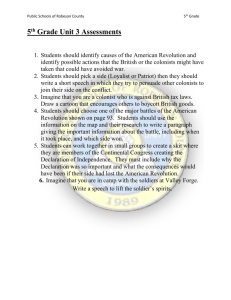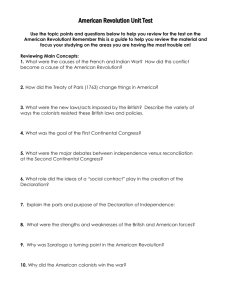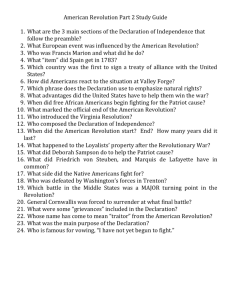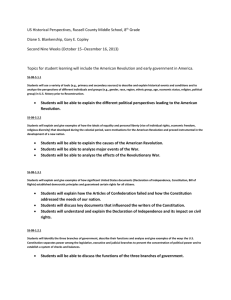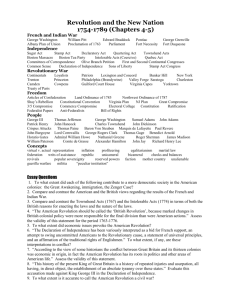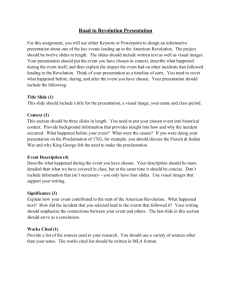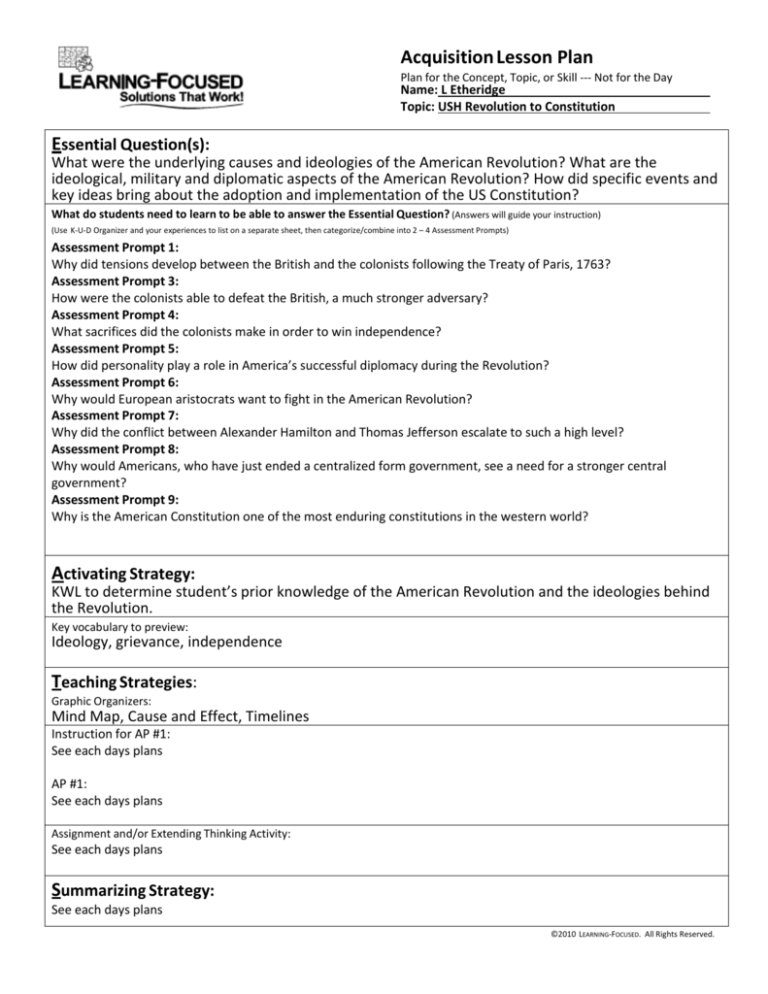
Acquisition Lesson Plan
Plan for the Concept, Topic, or Skill --- Not for the Day
Name: L Etheridge
Topic: USH Revolution to Constitution
Essential Question(s):
What were the underlying causes and ideologies of the American Revolution? What are the
ideological, military and diplomatic aspects of the American Revolution? How did specific events and
key ideas bring about the adoption and implementation of the US Constitution?
What do students need to learn to be able to answer the Essential Question? (Answers will guide your instruction)
(Use K-U-D Organizer and your experiences to list on a separate sheet, then categorize/combine into 2 – 4 Assessment Prompts)
Assessment Prompt 1:
Why did tensions develop between the British and the colonists following the Treaty of Paris, 1763?
Assessment Prompt 3:
How were the colonists able to defeat the British, a much stronger adversary?
Assessment Prompt 4:
What sacrifices did the colonists make in order to win independence?
Assessment Prompt 5:
How did personality play a role in America’s successful diplomacy during the Revolution?
Assessment Prompt 6:
Why would European aristocrats want to fight in the American Revolution?
Assessment Prompt 7:
Why did the conflict between Alexander Hamilton and Thomas Jefferson escalate to such a high level?
Assessment Prompt 8:
Why would Americans, who have just ended a centralized form government, see a need for a stronger central
government?
Assessment Prompt 9:
Why is the American Constitution one of the most enduring constitutions in the western world?
Activating Strategy:
KWL to determine student’s prior knowledge of the American Revolution and the ideologies behind
the Revolution.
Key vocabulary to preview:
Ideology, grievance, independence
Teaching Strategies:
Graphic Organizers:
Mind Map, Cause and Effect, Timelines
Instruction for AP #1:
See each days plans
AP #1:
See each days plans
Assignment and/or Extending Thinking Activity:
See each days plans
Summarizing Strategy:
See each days plans
©2010 LEARNING-FOCUSED. All Rights Reserved.
Acquisition Lesson Pacing Guide Name:
Topic:
Essential Question: What were the underlying causes and ideologies of the American Revolution?
How did Key individuals help to forge the new nation? How did specific events and key ideas bring
about the adoption and implementation of the US Constitution?
Using your EATS plan, pace the activities and instruction over 2 – 3 sessions (if more than 1 day):
Day 10/Class/Session 1
Day 11/Class/Session 2
Day 12/Class/Session 3
Activating Strategy:
Activating Strategy:
Daily 10
Meet students at the door and
take something of value to
them (IDs, pencils, etc). The
only explanation is that “it is for
their own good”. Ask students
how they felt having their
property taken without their
consent. Relate to how the
colonist felt being taxed by the
British.
Activating Strategy:
Daily 10
Show Microsoft’s short video
titled History Remembered –
Declaration of Independence.
Have students speculate on
how the colonists were able to
write the Declaration of
Independence without the
modern conveniences we enjoy.
Key Vocabulary and Strategy:
Key Vocabulary and Strategy:
Daily 10
Show students transparency
titled Forces of the American
Revolution which compares and
contrast British and Colonial
forces. Have them speculate as
to which is better prepared for
conflict. Explain.
Key Vocabulary and Strategy:
Albany Plan of Union , French and
Indian War , Treaty of Paris 1763 ,
Royal Proclamation of 1763 , customs
duties , John Hancock , Sugar Act , due
process , James Otis , inflation , Stamp
Act , Sons of Liberty , nonimportation
agreement , Townshend Acts , writs of
assistance , Sam Adams , Boston
Massacre , Crispus Attucks
Students copy into vocabulary section
of notebook and define.
committee of correspondence , Tea
Declaration of Independence
Act of 1773 , Boston Tea Party ,
Students copy into vocabulary section
Coercive Acts , Quebec Act ,
of notebook and define.
Intolerable Acts , First Continental
Congress , Second Continental
Congress , Battle of Bunker Hill , Olive
Branch Petition , Thomas Paine’s
Common Sense
Students copy into vocabulary section
of notebook and define.
Teaching Strategies:
Teaching Strategies:
Teaching Strategies:
Students read pages 116-123 in
textbook in preparation for class
Students read pages 126-133 in
textbook in preparation for class
Students read pages 134-137 in
textbook in preparation for class
Students will circle the wagons
by getting in four groups to
research the causes of tensions
between the colonists and Great
Britain (French and Indian War,
British policies to solve their
financial problems, Townshend
Acts, Stamp Act Crisis)
Using the Graphic Novel From
Revolution to Declaration,
students read the novel, then
complete a cause and effect
organizer showing the events
leading up the signing of the
Declaration of Independence
Have students read the
Declaration of Independence
while listening to the recording of
JFK reading the document.
Break apart the Declaration of
Independence and work together
to re-write the declaration in
language that is more modern
and understandable today.
List the grievances
View the Story of US, second
episode if time allows
Each group will add their
information to the class’ mind
map about tension between the
British and American Colonies
Create a cause and effect
organizer to illustrate the
escalating colonial reactions to
the Royal Proclamation Act,
Sugar Act, Stamp Act,
Townshend Acts, Tea Act and
Coercive Acts
Summarizing Strategy:
On the left side of your notes copy
and answer. Use your knowledge,
notes or textbook
1. What arguments did the Stamp
Act Congress make in protest
against the British Taxes?
2. Why do you think the British
were so willing to pass new
taxes in the face of colonial
opposition?
Summarizing Strategy:
On the left side of notebook, copy
and answer:
1. After King George III refused
to consider the Oliver
Branch petition, in what
ways did the Continental
Congress begin to act like
an independent
government?
2. What role did the
committees of
correspondence play in the
colonists’ move toward
independence
Summarizing Strategy:
Copy and answer the following on
the left side of notebook
1. Whose influence is seen in this
section?
2. Read the 3rd paragraph of this
section.
3. What does it mean?
Time permitting:
On the left side of your notes
imagine that you are a
member of the Sons or Liberty
or the Daughters of Liberty.
Time permitting:
Write a short letter to a friend
Imagine that you were a
explaining what your group
participant in the Boston
does and urging your friend to
Tea Party. Write a diary
join.
entry describing the event
©2010 LEARNING-FOCUSED. All Rights Reserved.
Day 13/Class/Session 4
Day 14/Class/Session 5
Day 15/Class/Session 6
Activating Strategy:
Activating Strategy:
Daily 10
Video Clip “The American
Revolution in 2 minutes or less.
Happily ever after.
Activating Strategy:
Daily 10
Key Vocabulary and Strategy:
Key Vocabulary and Strategy:
Key Vocabulary and Strategy:
guerilla warfare , Crossing the
Delaware, Valley Forge , Marquis de
Lafayette, Benedict Arnold ,
Saratoga, John Paul Jones , General
Charles Cornwallis, Battle of
Yorktown ,
Articles of Confederation, Northwest James Madison, Alexander Hamilton,
Ordinance , duties , recession , Shays' Virginia Plan, New Jersey Plan, Great
Compromise, Three-Fifths
Rebellion
Compromise, popular sovereignty,
Students copy into vocabulary
federalism, separation of powers,
section of notebook and define.
legislative branch, executive branch,
Students complete a crossword
judicial branch, checks and balances,
puzzle using vocabulary words from
veto, impeach, amendments
Vocabulary Quiz
Daily 10
Based on your prior knowledge,
write three things that you
already know about The
American Revolution into the
third section of your notebook.
Students copy into vocabulary
section of notebook and define.
Students copy into vocabulary
section of notebook and define.
Vocabulary Quiz
Teaching Strategies:
Teaching Strategies:
Teaching Strategies:
Students read pages 138-145 in
textbook in preparation for class
View the Discovery video The
American Revolution From
Colonies to Constitution The War
for Independence (15 min)
Graphic organizer that
summarizes the achievements
of the Articles of
Confederation
Create a timeline using the vents
depicted in the video
Discuss France’s role in the War
for Independence.
o Why did France wait to
join an alliance with the
colonies?
Chart listing the basic
strengths/weaknesses of the
articles of confederation
Notes/discussion on Shay’s
rebellion
o Who convinced France to
join the alliance?
o How did the addition of
France as an ally affect
the war’s outcome?
View Battle Animation on the
Battle of Yorktown at ,
http://revolutionarywaranima
ted.com/yorktown
Discuss the Geography of the
battle of Yorktown, the role of
Students read pages 158-162 in
textbook in preparation for class
Students read pages 164-169 in
textbook in preparation for class
Students complete a
Constitution Scavenger Hunt
Debrief Scavenger Hunt
Lord Cornwallis and the Treaty
of Paris
Create a graphic organizer to
list the provisions of the
Treaty of Paris
Summarizing Strategy:
On the left side of the notebook
– Imagine that you are a colonist
during the revolutionary War,
write a letter to convince
Europeans to support the
Americans in the war.
Summarizing Strategy:
Summarizing Strategy:
Vocabulary puzzle = homework
if not finished.
Summarize all of the compromises
reach at the On the left side of the
notebook: Constitutional
Convention in Philadelphia
Day 16/Class/Session 7
Day 17/Class/Session 9
Activating Strategy:
Activating Strategy:
Daily 10
Daily 10
Bugs Bunny Constitution Cartoon.
Discuss how the Constitution
changes with the needs of the
nation.
Key Vocabulary and Strategy:
Federalists, Anti-federalists , The
Federalist
Key Vocabulary and Strategy:
Albany Plan of Union , French and Indian War , Treaty of Paris 1763 , Royal
Proclamation of 1763 , customs duties , John Hancock , Sugar Act , due
process , James Otis , inflation , Stamp Act , Sons of Liberty , nonimportation
Students copy into vocabulary section agreement , Townshend Acts , writs of assistance , Sam Adams , Boston
Massacre , Crispus Attucks, committee of correspondence , Tea Act of 1773 ,
of notebook and define.
Boston Tea Party , Coercive Acts , Quebec Act , Intolerable Acts , First
Continental Congress , Second Continental Congress , Battle of Bunker Hill ,
Olive Branch Petition , Thomas Paine’s Common Sense , Declaration of
Independence , guerilla warfare , Crossing the Delaware, Valley Forge ,
Marquis de Lafayette, Benedict Arnold , Saratoga, John Paul Jones , General
Charles Cornwallis, Battle of Yorktown , Articles of Confederation,
Northwest Ordinance, duties , recession , Shays' Rebellion, James Madison,
Alexander Hamilton, Virginia Plan, New Jersey Plan, Great Compromise,
Three-Fifths Compromise, popular sovereignty, federalism, separation of
powers, legislative branch, executive branch, judicial branch, checks and
balances, veto, impeach, amendments, Federalists, Anti-federalists , The
Federalist
Teaching Strategies:
Students read pages 172-175 in
textbook in preparation for class
Ratification debate
Teaching Strategies:
Summarizing Strategy:
Summarizing Strategy:
Summarize each sides arguments
in notebooks
(Can be one of the AP’s or Students answer EQ if finished)
Unit Test
Know-Understand-Do Organizer
Name: Lorrie Etheridge
Course/Subject: US History
Topic: United States Revolution to Constitution
Which Standards are students learning in this unit?
Elaborated Unit Focus: The unit begins with an examination of the causes of the American Revolution, including its
ideological background. The middle section of the unit focuses on the roles of key individuals in forging a new
nation in the crucible of conflict. The unit concludes by examining events and key ideas that led to the creation of
the Constitution and Bill of Rights.
GPS Standards:
SSUSH3 The student will explain the primary causes of the American Revolution.
a. Explain how the end of Anglo-French imperial competition as seen in the French-Indian War, and the 1763 Treaty
of Paris, laid the groundwork for the American Revolution.
b. Explain colonial response to British actions such as the Proclamation of 1763, Stamp Act, and the Intolerable Acts
as seen in Sons and Daughters of Liberty and Committees of Correspondence.
c. Explain the importance of Thomas Paine’s Common Sense to the movement for independence.
SSUSH4 The student will identify the ideological, military, and diplomatic aspects of the American Revolution.
a. Explain the language, organization, and intellectual sources including the writings of John Locke and
Montesquieu on the Declaration of Independence and the role of Thomas Jefferson.
b. Explain the reason for and significance of the French alliance and foreign assistance and the roles of Benjamin
Franklin and the Marquis de Lafayette.
c. Analyze George Washington as a military leader, including the creation of a professional military and the life of a
common soldier, crossing the Delaware River, and Valley Forge.
d. Explain the role of geography as the Battle of Yorktown, the role of Lord Cornwallis, and the Treaty of Paris,
1783.
SSUSH5 The student will explain specific events and key ideas that brought about the adoption and
implementation of the United States Constitution.
a. Explain how weaknesses in the Articles of Confederation and Daniel Shays’ Rebellion led to a call for a stronger
central government.
b. Evaluate the major arguments of the anti-Federalists and Federalists during the debate on ratification of the
Constitution as put forth in The Federalist concerning form of government, factions, checks and balances, and the
power of the executive, including the roles of Alexander Hamilton and James Madison.
c. Explain the key features of the Constitution, specifically the Great Compromise, separation of powers (the
influence of Montesquieu), limited government, and the issue of slavery.
d. Analyze how the Bill of Rights serves as a protector of individual and states’ rights.
By the end of this unit, students will be able to…
KNOW:
UNDERSTAND
DO:
Vocabulary:
Albany Plan of Union
French and Indian War
Treaty of Paris 1783
Royal Proclamation of 1763
customs duties
John Hancock
Sugar Act
due process
James Otis
inflation
Stamp Act
Sons of Liberty
nonimportation agreement
Townshend Acts
writs of assistance
Sam Adams
Boston Massacre
Crispus Attucks
committee of correspondence
Tea Act of 1773
Boston Tea Party
Coercive Acts
Quebec Act
Intolerable Acts
First Continental Congress
minutemen
Loyalists
Patriots
Second Continental Congress
George Washington
Battle of Bunker Hill
Olive Branch Petition
Thomas Paine
Common Sense
Thomas Jefferson
Declaration of Independence
guerilla warfare
Crossing the Delaware
Valley Forge
Marquis de Lafayette
Benedict Arnold
Saratoga
John Paul Jones
General Charles Cornwallis
Battle of Yorktown
Article of Confederation
Northwest Ordinance
duties
recession
Shays' Rebellion
James Madison
Alexander Hamilton
Virginia Plan
Ideas and interests that are in
direct conflict with existing
governments may cause
revolutions.
The philosophical principles of
American democracy were laid
with the Declaration of
Independence, the United States
Constitution, and the Bill of Rights.
Fighting a war comes at a great
cost.
Individuals play a role in creating
a nation.
Nations build upon both
compromise and conflict.
Why was winning the French and
Indian War the beginning of
conflict for the British and the
colonists? (USH3a)
Why did the British and the
colonists have different goals
following the Treaty of Paris, 1763?
How were the colonists able to
defeat the British, a much stronger
adversary? (USH4b, c; USH5d)
What sacrifices did the colonists
make in order to win
independence? (USH4c, d)
How did personality play a role in
America’s successful diplomacy
during the Revolution? (USH4b)
Why would European aristocrats
want to fight in the American
Revolution? (USH4b)
Why did the conflict between
Alexander Hamilton and Thomas
Jefferson escalate to such a high
level? (USH5b)
Why would Americans, who have
just ended a centralized form
government, see a need for a
stronger central government?
(USH5a, b)
Why is the American Constitution
one of the most enduring
constitutions in the western
world? (USH5c, d)
New Jersey Plan
Great Compromise
Three-Fifths Compromise
popular sovereignty
federalism
separation of powers
legislative branch
executive branch
judicial branch
checks and balances
veto
impeach
amendments
Federalists
Antifederalists
The Federalist
popular soveriegnty
federalism
enumerated powers
reserved powers
concurrent powers
override
impeach
constituents
bills
Supreme Court
judicial review
due process
preamble
constitution
elastic clause
treason
amendment
ratification
quarter
common law
majority
president-elect
District of Columbia
Facts:
Causes and ideological baclground
of the American Revolution
roles of key individuals in forging a
new nation
key events and ideas that led to the
creation of the Constitution and Bill f
Rights

